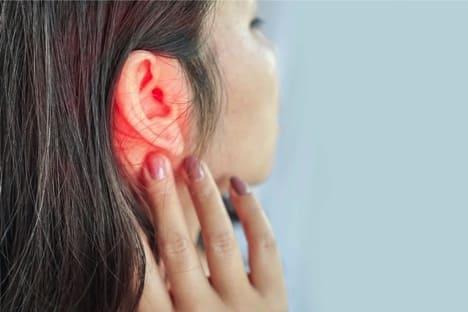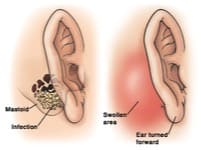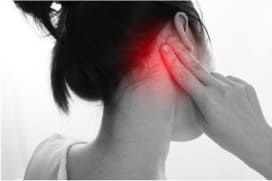Pain behind ear
14
July
2021

What is Pain Behind Ear?
Since the ears and the mastoid bones (which are the bones that protect the ears and are full of air cells) contain many blood vessels and nerves, they are considered very sensitive areas and they are vulnerable to pain. Therefore, pain behind the ear is not common but is also likely to happen in case of any simple irritation. The pain can be felt as a dull and throbbing sensation behind the ears, in the upper neck, or in back of the head. The pain may also be referred to the jaws and the cheeks. It is also important to know that if the pain happens exclusively in the ear, it does not mean that it is an ear infection, or an issue related directly to the ear. The ear has many nerves connected to the neck and the head, so they can easily be the reason.
Several possible conditions can be the main cause behind your pain; they can be related to ear infections, jaw joint issues, teeth problems, and many others. Identifying the condition is not an easy task but the most common causes can be Swimmer’s ear, Temporomandibular joint disorders (TMJ), Otitis media (middle ear infection), Earwax buildup, Occipital neuralgia, and Mastoiditis.
Monitoring your symptoms is an essential step to make sure that everything is okay, and seeing a doctor is crucial in case the pain isn’t getting any better. Anything can be the cause of your pain, whether it was a minor infection or a dangerous tumor; that is why it is important to seek medical help in the following cases:
when the pain persists for a long period of time,
when you can feel any type of neck mass or lump,
when there is blood coming out of your ear.
A proper diagnosis is crucial in order to know the exact condition that is resulting this pain, and to get the appropriate treatment for it. The doctor will ask you questions about your health and medical history, they will do a physical examination and the other steps will depend on the first two.
“When under a doctor’s care, someone will have a treatment plan for headaches behind the ear that will include managing the pain and treating underlying causes of the pain.” (Medical News Today, 2020). But treating the pain at home alongside with the doctor’s recommendations is a primary method to ease the pain; for example, you can take over-the-counter anti-inflammatory drugs, get a massage for your neck, and apply heat packs on the back of your neck.
What Causes Pain Behind the Ears?
Seeking a healthcare provider is essential because there are many potential conditions for pain or a headache behind the ear, and you need a proper diagnosis to be able to treat it and ease the pain. The potential conditions, that are not always possible to identify, can include:
-
Swimmer’s Ear: It is also known as Otis externa, is an infection that occurs in the outer ear canal. “ It is often brought on by water that remains in your ear after swimming, creating a moist environment that aids bacterial growth. Putting fingers, cotton swabs, or other objects in your ears also can lead to swimmer's ear by damaging the thin layer of skin lining your ear canal.” (Mayo Clinic, 2019). Treating this condition is an easy task because it is usually treated with eardrops. Symptoms include clear or yellow-green discharge, a full sensation in the ear, and redness and swelling of the ear canal. Whenever you experience these symptoms, you should check with your doctor because it can worsen with time. The eardrop prescribed may contain antibiotics, but if your infection is severe, you may need oral antibiotics as well.
-
Occipital Neuralgia: This is one of the most common conditions that causes pain behind the ear. It is described as a one sided electric-shock-like chronic pain in your upper neck, behind your ear, and at the back of your head. People often mistake it for a migraine because of the sharp pain felt behind the ear, but this condition normally begins in your neck, then starts heading upwards. “Some people feel pain in the forehead or behind the eyes. It can even cause scalp sensitivity” (Healthline, 2019). Occipital neuralgia occurs when the pain is a result of pressure on the occipital nerves which can be caused by injuries or inflammation; most of the time, doctors find a difficulty identifying its cause. When you are feeling extreme pain, the healthcare provider might prescribe antidepressants, and local nerve blocks and injections of steroids in the affected area.
-
Temporomandibular Joint Disorders (TMJ): The temporomandibular joint is the joint that connects the jaw to the skull, there is one on each side. When you have this condition, you will find a difficulty in articulating your jaw or controlling any other movement in your face. The exact cause is often left undetermined because the pain can be led by several factors such as jaw injury, genetics, and arthritis. It usually does not need any treatment; you can take care of yourself at home. Surgery is the last resort for Temporomandibular joint disorders, it is usually done when all of the other measures do not work. Seek immediate medical help when the pain persists and if you can not move your jaw at all.
-
Mastoiditis: It is a dangerous bacterial infection that happens in the part behind your ear called the mastoid bone; it happens more frequently in children than in adults. This condition occurs when the bone becomes infected or inflamed due to untreated infections in the middle ear. The symptoms of mastoiditis typically include hearing loss in the affected side of the ear, discharge coming out of the ear, a high temperature, swelling and redness. As soon as you experience symptoms of mastoiditis, especially when you have already been diagnosed and the treatment is not working, head to your doctor’s clinic or hospital immediately. To treat mastoiditis, you will need to have a myringotomy in order to drain the middle ear or a mastoidectomy to remove the infected part of the mastoid bone.
-
Earwax Buildup: Earwax, also known by its medical name “cerumen”, is made by your body for the purpose of protecting your ears. When the earwax buildup is left untreated, you will probably experience hearing loss, pain, dizziness, soreness, and ringing sensations in the ear. It is very easy to identify the problem in this case because the doctor will insert an instrument in your ear which will enable them to see if there is any earwax buildup.
-
Dental Causes: Sometimes, when the person is suffering from a tooth abscess, the brain mistakenly thinks that the pain is caused directly by the ear and consequently signals pain receptors in the ears instead of the tooth which explains the manifestation of behind the ear pain when it is not the original cause.
-
Ramsay Hunt Syndrome: Also known as “herpes zoster oticus”, occurs mainly when an outbreak of shingles takes place and originates from the same virus that causes the chickenpox disease, which is the varicella zoster virus. When this syndrome occurs, the inactive form of the varicella zoster virus gets activated and causes facial paralysis and a painful red blistering rash affecting the ear or mouth.



How do we diagnose behind ear pain?
Since pain behind the ear can originate from a multitude of reasons, proper diagnosis is essential to guarantee a smooth recovery. The steps applied by a physician are as follows:
Checking the medical history
Getting information about any recent neck, head, or spine injury
Running physical examinations to check if the pain is caused by “occipital neuron”. The examination is done by pressing firmly around the back of the head. An additional method is injecting a shot to numb the pain. If the pain goes away, then the occipital nerve is likely to be the cause.
In severe cases, blood tests and an MRI are recommended by the doctor in order to rule out other potential causes.
If the patient has fever, or discharge coming out of their ear, the doctor will check for mastoiditis.
If all possible causes are ruled out, the doctor examines the jaw and recommends the patient to visit a dentist.

How do we treat the cause of behind ear pain?
Depending on the cause, a treatment is offered for the patient:
Occipital Neuralgia: Pain relievers, anti-inflammatory medications, muscle relaxants are recommended in this case since the pain is caused by problems in the neck. Moreover, the patient should exercise their neck and avoid keeping it in the same position for too long. In more complicated cases, corticosteroids may be injected to relieve the pain.
Mastoiditis: Antibiotics are prescribed first. In case no improvement was observed, the middle ear should be drained. In more severe cases, a part of the mastoid bone should be removed.
TMJ: Pain relievers, anti-inflammatories and muscle relaxants are a must to soothe the pain. Physical therapy, oral splints, arthrocentesis (removal of joint fluid), corticosteroid injections, arthroscopic and open joint surgery are also available treatments.
If you or anyone you know is suffering from pain, call us today on (469) 562 4188 to book an appointment with our expert doctors.